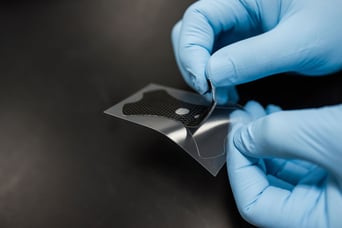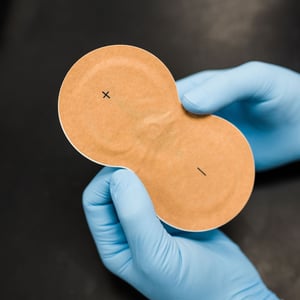Though pills have been in use since 1500 BC, the pharmaceutical industry has dedicated a significant amount of time and resources towards perfecting them throughout the last century. However, while modern pills are a tremendous improvement over their predecessors, one significant challenge remains: pills must pass through the digestive system. Therefore, pills are slow to enter the bloodstream, can cause additional side effects, and must be chewed or swallowed, which can be difficult for some patients with Central Nervous System (CNS) conditions.
It’s almost impossible to foresee a time when most treatments won’t be delivered in pill form. However, there is a relatively new option for drug manufacturers that wish to elegantly sidestep the many disadvantages commonly associated with pill-based therapy: the transdermal patch.
What is a Transdermal Patch?

A transdermal patch is an adhesive patch containing medication. When placed on the skin, a specific dose of medication can be slowly absorbed into the bloodstream. Transdermal patches can treat many different conditions, and offer a wealth of advantages over pills.
Advantages of Transdermal Patches
Medication delivered via transdermal patch doesn’t have to be chewed or swallowed, and isn’t metabolized through the digestive system or liver, which, in turn, typically reduces the amount and the severity of any side effects. Transdermal patches are comfortable and convenient, which boosts patient compliance. Medication that’s delivered through transdermal patches can enter the bloodstream quickly, but patches also can provide a more sustained drug delivery – up to seven days.
For drug manufacturers, transdermal patches have a few added benefits: they can be more shelf-stable than injectables, and they tend to drive demand by pleasing both patients and their prescribing physicians with improved compliance, ease of use, and effectiveness.
The History of Patch Therapy
Much has been made of patch therapy in recent years, and in fact, our next COVID-19 vaccine could potentially be delivered into our bodies through a fingertip-sized patch. However, topical treatments are referenced in some of the earliest written records, and Chinese healers were using medicated plaster treatments to treat a variety of conditions in 2000 BC.
Modern transdermal patch technology has also been with us for a relatively long period of time—the first patch treatment was approved by the FDA in 1979 to treat motion sickness. Shortly afterward, patches were also approved to treat heart problems, but transdermal patches didn’t enter public consciousness until nicotine patches became available in the early ‘90s. Today, patches are frequently used to deliver birth control, as well as treat Alzheimer’s disease, Parkinson’s, substance abuse, and chronic pain.
How do Transdermal Patches Work?
When a transdermal patch is applied to the skin, the medication inside the patch passes through the skin and ultimately enters either the lymph system or the bloodstream. Depending on the type of transdermal patch, it is left on the skin for a prescribed period of time, so medication can be slowly absorbed by the body.
Typically, transdermal patches would be applied to a hairless and flat portion of the skin, often the back, certain areas of the chest, the sides of the waist, or the upper arms. While many patches are not designed to be placed on an area of the body that must bend, Tapemark’s proprietary IontoPatch was specifically designed to treat elbows, knees, wrists, feet, and shoulders.
Types of Transdermal Patches
Transdermal patches have come a long way since their successful introduction in the 1970s. There are now a wide variety of transdermal patches, but these are the most common:
- Single-Layer Drug-in-Adhesive: The simplest and oldest type of patch, which combines medication with a single layer of adhesive. When applied, the medication is slowly released into the skin.
- Multi-Layer Drug-in-Adhesive: This modification in design is used to create patches that are designed for longer-term use. As the name would suggest, these patches contain more than one layer of medication combined with an adhesive. Each layer will only begin releasing its medication after the layer closer to the skin has finished.
- Reservoir: Not everyone’s skin has exactly the same rate of permeability, and the reservoir patch was designed so that its own rate-controlling membrane determines the rate of absorption. In a reservoir patch, active ingredients are stored separately from the adhesive, in a liquid. When applied, the medication slowly passes through the membrane and the adhesive before it enters the skin.
- Matrix: Because reservoir patches store active ingredients in a liquid layer, they cannot be trimmed, and tend to be large. Matrix patches store their active ingredients in a semi-solid layer, or matrix. Matrix patches are thinner and more comfortable than reservoir patches and are less expensive to produce. Currently, they’re frequently used to treat a variety of neurologic conditions.
- Vapor Patch: Vapor patches were designed to release vapor through their adhesive layer, and are often used to deliver decongestants and sleep aids.
- Iontophoresis Patch: Designed to reduce inflammation and relieve pain, these patches contain a pouch of medication, and typically require being connected to an ionto machine to be effective. This machine applies a small electrical current to allow medication to be more readily absorbed into the skin.
- Microneedle Patch: These transdermal patches were designed to offer an alternative to uncomfortable and often impractical hypodermic needles. Microneedle patches use microscopic needles to penetrate the skin just enough to allow drugs to enter the bloodstream.
Tapemark’s Innovations
Unfortunately, the only drugs that can be effectively delivered through a transdermal patch are those that can be absorbed through the skin, or in the case of vapor patches, safely dispersed into the air. Because transdermal patches offer many advantages for both patients and prescribers, there is currently an unmet demand for patches that can deliver a broader variety of medications, providing an excellent opportunity for drug developers.
Tapemark has created three proprietary transdermal patches to make patch therapy more convenient, and increase the types of medications patches can deliver: MacroPerm, MicroDerm, and the IontoPatch. Let’s explore each of these in more detail.
MACROPERM
Larger molecules have presented historic difficulty to transdermal patch manufacturers. However, our MacroPerm patch is designed to transport Active Pharmaceutical Ingredients (API) of up to 25,000 daltons. The MacroPerm patch makes it possible for transdermal patches to treat a much broader range of health issues, and improve outcomes for patients and providers alike.
MICRODERM
Our MicroDerm patch uses microneedle technology to deliver a wide range of drugs to patients. In the future, we anticipate being able to provide better diabetes management tools and deliver vaccines, larger molecules, proteins, peptides, and other biologics via microneedle patch.
IONTOPATCH (IONTOPHORESIS PATCH)
The IontoPatch was referenced earlier for its added flexibility. Our IontoPatch is a type of iontophoresis patch, with a few key differences. It can be placed over a part of the body that moves, like a knee, elbow, or shoulder. This patch does not require the assistance of a separate ionto machine to deliver an electrical current, so it can be used on the go. Furthermore, it is designed to be wrap-able, compressible, and weight-bearing, making it ideal for active users.
How to Pioneer New Transdermal Patch Therapies
Tapemark is a full-service CDMO that has facilitated 82 commercial product launches in the past 20 years, with an audit rate of 100%. Our 150,000-square-foot facility has not only the capacity, but also the state-of-the-art equipment to take complex projects from early-stage development through commercial manufacturing and shipping. Depending on your specific needs, you can partner with us for all or part of the development and manufacturing process. To get started, fill out the form through the link below.
